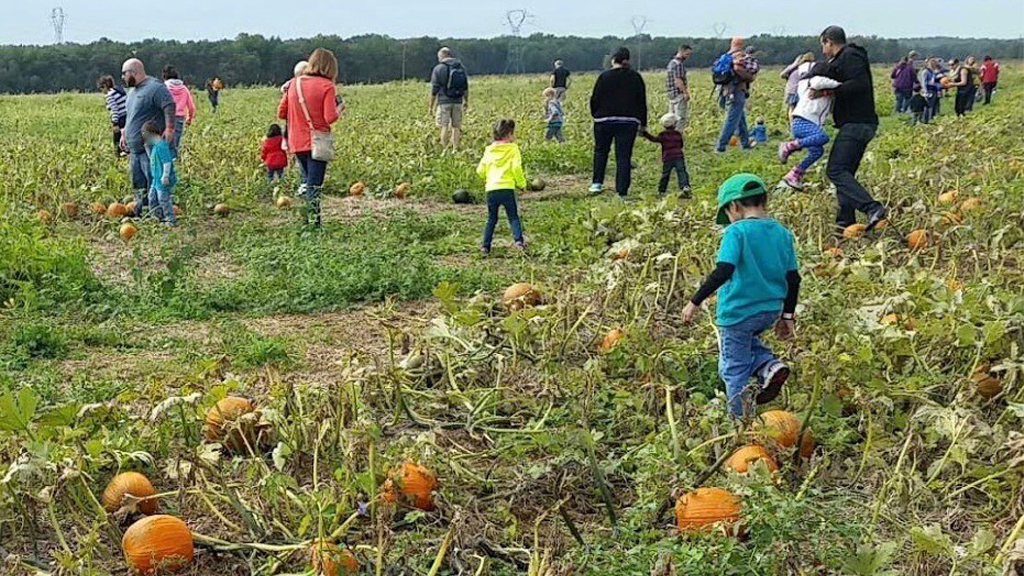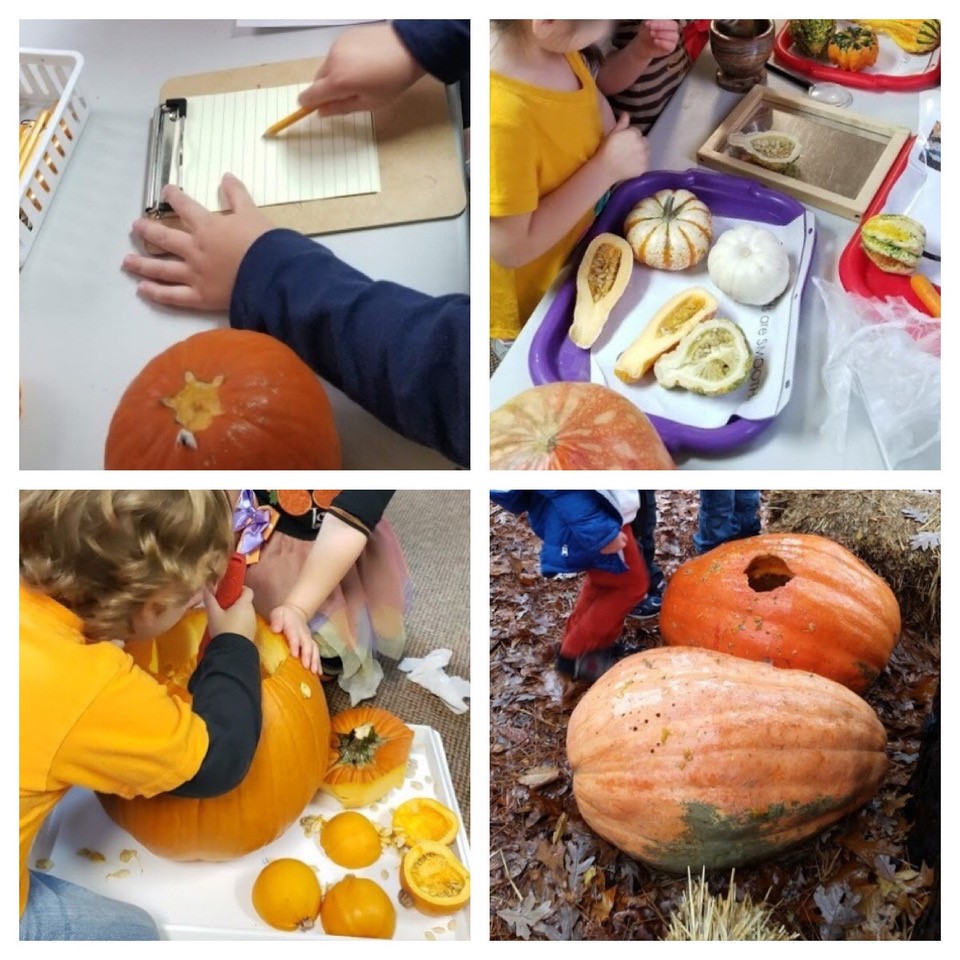Early Childhood / Preschool Blog
The Symbol of Joyful Learning Is a Pumpkin
By Sarah Marie Maynard
Posted on 2020-06-30

Disclaimer: The views expressed in this blog post are those of the author(s) and do not necessarily reflect the official position of the National Science Teaching Association (NSTA).
Sarah Marie Maynard has been a preschool teacher at St. Matthew's Day School in Virginia for five years. She is the co-President of VAAEYC Prince William Chapter, and an active member of NAEYC’s Early Childhood Science Interest Forum.
Hear me out: Where does your classroom kick start their joyful learning experiences? Is there a place where you feel like suddenly you’re clicking as a classroom full of excited and passionate explorers, full of questions and seeking, and ready to know more? For me, that place is in the presence of a pumpkin.
Every year, my preschool has visited the pumpkin patch. Not just students, but teachers, parents, extended families, and friends all become a part of our experience, providing “structure [to] their experiences, support[ing] learning attempts, and regulat[ing] the complexity and difficulty of levels of information (NRC 2007, p. 3). We’re all learning together! We pile into wagons pulled by tractors and rumble slow and dusty past fields, farmhouses, animals, and every size and shape of farm equipment imaginable. When the tractors lurch to a stop, hundreds of eager little feet race out into the fields filled with tumbling green vines, and—just peeping out—pumpkins. And the discoveries of adults and children alike begin:
- Did you know that pumpkins grow on long, tangled vines? The vines are twisted and scratchy, and will trip you if you don’t take tall steps.
- Did you know that pumpkins are the fruit of a yellow flower?
- Did you know that not all pumpkins are orange?
- Did you know that some bugs like the pumpkin blossoms, and some bugs like the pumpkins?
- Did you know that sometimes when you pick up a pumpkin, it’s soft, squishy, and sour-smelling?
Before leaving, every teacher selects pumpkins, small sections of vine, and a blossom or two. All of these things return to the classroom.
Back in the classroom, our young friends find that the adventure they shared with their parents, siblings, peers, and teachers is not over. Tractors appear in the block center to bump along carpet roads, along with farm animal toys and tiny decorative gourds. Vines are examined in minutiae with magnifying glasses, measuring tapes, strings, hands, feet, and friends. “This vine is three foots long!” But only one “teacher foot” long, we noticed.
Together, children and teachers watch the green pumpkins slowly change to orange pumpkins. We make predictions about the changes we will see in our white pumpkin, and we learn that not all pumpkins are orange! We examine the textures of all different sizes and shapes of gourds, inside and out. Sometimes it’s too intimidating to thrust a hand into the slimy darkness of a pumpkin, so young friends help each other explore by creating “viewing stations” where sliced pumpkins are available for all comfort levels. Soon these pumpkins begin to change! We watch as they disintegrate.
Teachers help guide students into good laboratory habits while we examine and understand these changes: wearing goggles, washing our hands thoroughly, and using tools like magnifying glasses and popsicle sticks to closely observe, without touching.
Preschoolers share their observations with peers and their community with drawings, preschool writing (teacher code for scribbles, but please remember this is a very valid form of communication!), oral descriptions, and photographs.
Children were surprised to find pumpkins placed under the trees in our playground. These pumpkins were so large we couldn’t move them unless we pushed them with our whole bodies. For a while these make excellent places to read and climb, but then the children notice that the wildlife we share our space with—squirrels and birds—have started to nibble on them. From a small hole, to a large hole, to a decayed puddle of pumpkin, we watch as it slowly changes.
And months later, in the spring, as we begin to prepare for a new year, we notice that there are sprouts in the place where the huge pumpkins once rested. We make predictions and observe; this year, the slugs have a tasty treat, and no big vines appear. In the classroom we sing about five little pumpkins, sitting on a wall, being made into pumpkin pie, one at a time.

The richness of this pumpkin patch experience extends beyond the day trip, into our school community, our classrooms, and the community at large. We revisit this experience annually, adding to our established knowledge, and our expertise. It continues to resonate, as our students return in their first- and second-grade years, with new little siblings. Friends who moved away come back to join our fun.
By returning to pumpkins again and again, and providing “varied experiences and materials to learn key content and principles of science” (NAEYC 2019), our learners experience all of the key principles of science learning in NSTA's Early Childhood Science Education position statement, as they start our preschool year off on a strong foot, and experience a joy and depth of knowledge that resonates through their entire learning lives.
This year, as with every other aspect of our lives, the pumpkin patch visit will present unprecedented challenges. Perhaps instead of crowded into a wagon, family groups can hike together toward the pumpkins, providing social distance while allowing us all to enjoy the scenic farm vistas on foot? But to quote the inimitable Jeff Goldblum playing the part of Dr. Ian Malcolm, “Life, uh, finds a way.” Preschool always presents challenges, and the teachers of the early childhood community are ready for the challenge. We’ll figure it out! We’ll get back to my pumpkin!
Resources
National Association for the Education of Young Children (NAEYC). 2019. NAEYC Early Learning Program Accreditation Standards and Assessment Items. https://www.naeyc.org/sites/default/files/globally-shared/downloads/PDFs/accreditation/early-learning/standards_and_assessment_2019.pdf.
National Research Council (NRC). 2007. Taking science to school: Learning and teaching science in grades K–8. Washington, DC: National Academies Press. https://www.nap.edu/catalog/11625/taking-science-to-school-learning-and-teaching-science-in-grades
National Science Teaching Association. 2014. Early Childhood Science Education position statement. https://www.nsta.org/nstas-official-positions/early-childhood-science-education


